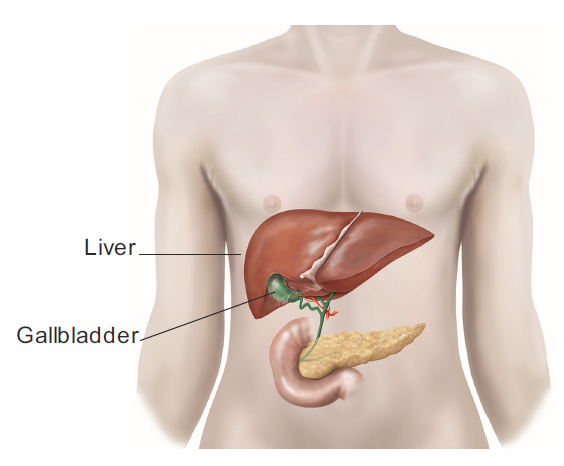Gallbladder surgery (laparoscopic cholecystectomy)

The liver and gallbladder
- Gallstones are stones that form in your gallbladder.
- They are common and can run in families.
- The risk of developing gallstones increases as you get older and if you eat a diet rich in fat.
For some people gallstones can cause severe symptoms, with repeated attacks of abdominal pain being the most common.
What are the benefits of surgery?
You should be free of pain and able to eat a normal diet. Surgery should also prevent the serious complications that gallstones can cause.
Are there any alternatives to surgery?
The gallstones can be left alone but this may lead to complications later. Surgery is suggested as it is the only dependable way to cure the condition.
It is possible to dissolve the stones or even shatter them into small pieces but these techniques involve unpleasant drugs that have side effects and a high failure rate.
Antibiotics can be used to treat any infection of your gallbladder. Eating a diet low in fat may help to prevent attacks of pain.
However, these alternatives will not cure the condition and symptoms are likely to come back.
What happens if I don't have the operation or the operation is delayed?
Your gallstones may not cause any symptoms. If you have already had symptoms, it is likely that these will continue from time to time. There is a small risk of life-threatening complications.
If you develop any of the following symptoms, contact your healthcare team:
- jaundice (yellow discolouration of the whites of the eyes, pale stools and dark urine)
- constant, severe abdominal pain that does not get better after several hours
- high temperature
What does the operation involve?
The operation is performed under a general anaesthetic and usually takes about an hour.
Your surgeon will use laparoscopic (keyhole) surgery as this is associated with less pain, les scarring and a faster return to normal activities. They will make several small cuts on your abdomen so they can insert tubes (ports) into your abdomen. Your surgeon will insert surgical instruments through the ports along with a telescope so they can see inside your abdomen and perform the operation.
Your surgeon will remove your gallbladder from your abdomen through one of the ports.
How can I prepare myself for the operation?
If you smoke, stopping smoking now may reduce your risk of developing complications and will improve your long-term health.
Try to maintain a healthy weight. You have a higher risk of developing complications if you are overweight. Your surgeon may suggest you follow a special diet for the 2 weeks before the procedure to reduce the size of your liver. The liver is a large organ that needs to be lifted to perform the surgery. If it is smaller, the risk of complications such as bleeding are reduced.
Regular exercise should help to prepare you for the operation, help you recover and improve your long-term health. Before you start exercising, ask the healthcare team of your GP for advice.
Speak to the healthcare team about any vaccinations you might need to reduce your risk of serious illness while you recover. When you come into hospital, practise hand washing and wear a face covering when asked.
What complications can happen?
Some complications can be serious and can even cause death.
General complications of any operation
- Bleeding
- Developing a hernia in the scar
- Infection of the surgical site (wound)
- Blood clot in your leg
- Blood clot in your lung
- Chest infection.
Specific complications of this operation
Keyhole surgery complications
- Damage to structures such as your bowel, bladder or blood vessels
- Developing a hernia near one of the cuts
- Surgical emphysema (a crackling sensation in your skin caused by trapped carbon dioxide)
- Gas embolism.
Cholecystectomy complications
- Leaking of bile or stones
- Retained stones in your common bile duct
- Continued pain
- Needing to go to the toilet more often
- Inflammation of the lining of your abdomen
- Bile duct injury (narrowing or blockage)
- Allergic reaction to equipment, materials, medication or dye
- Bowel injury
- Pancreatitis if a stone moves into your common bile duct
- Serious damage to your liver or its associated blood vessels
- Tissues can join together in an abnormal way.
Consequences of this procedure
- Pain
- Unsightly scarring of your skin.
Summary
Gallstones are a common problem. An operation to remove your gallbladder should result in you being free of pain and able to eat a normal diet.
Where to get help
Acknowledgements
Patient Safety & Clinical Quality
EIDO Healthcare Australia

The operation and treatment information on this page is published under license by Department of Health Western Australia from EIDO Healthcare Australia and is protected by copyright laws. Other than for your personal, non-commercial use, you may not copy, print out, download or otherwise reproduce any of the information. The information should not replace advice that your relevant health professional would give you.